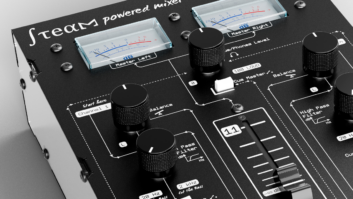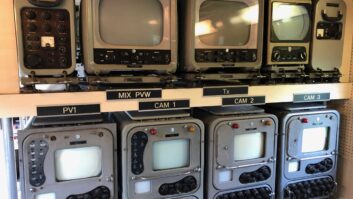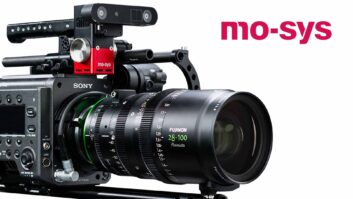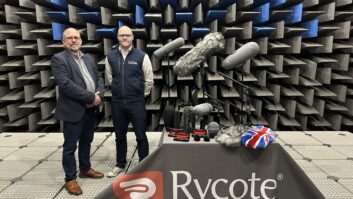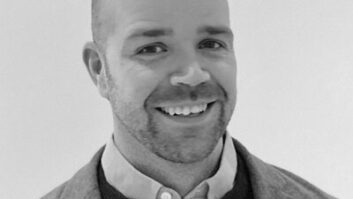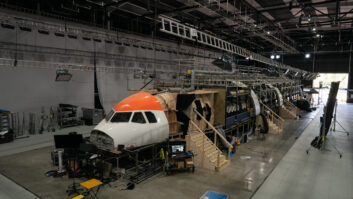 When director Jim Field Smith and co-creator George Kay conceived the idea for a series set on a plane, the simpler and easier option would have been to use an existing airliner or the husk of a disused one. However, they opted for artistic freedom and authenticity, boldly constructing the entire plane from scratch within Apple TV’s new studios in Symmetry Park, Aston Clinton, near Aylesbury in Buckinghamshire.
When director Jim Field Smith and co-creator George Kay conceived the idea for a series set on a plane, the simpler and easier option would have been to use an existing airliner or the husk of a disused one. However, they opted for artistic freedom and authenticity, boldly constructing the entire plane from scratch within Apple TV’s new studios in Symmetry Park, Aston Clinton, near Aylesbury in Buckinghamshire.
“It’s a different scenario if it’s just a few scenes or a single stunt sequence, but that was our home for nine months,” Smith reveals. “Many films and scenes from films have been set on planes, but never an entire series like this one. All the parts belong to real planes, but I wanted the actors and crew to be able to walk from the cockpit to the rear galley. The only way to achieve that was to build a plane.”
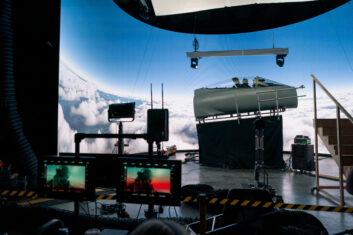 Another soundstage housed a colossal composite set, serving as the government offices and the UK Air Traffic Control Centre. Two more stages accommodated swing sets and other props integral to the production schedule, including a 6-axis motorised gimbal which the cockpit could be mounted on, enclosed within a giant 270-degree LED volume.
Another soundstage housed a colossal composite set, serving as the government offices and the UK Air Traffic Control Centre. Two more stages accommodated swing sets and other props integral to the production schedule, including a 6-axis motorised gimbal which the cockpit could be mounted on, enclosed within a giant 270-degree LED volume.
Hijack is a gripping seven-part series on Apple TV+, with Idris Elba as Sam Nelson, a skilled business negotiator who has the misfortune of being aboard the hijacked Kingdom airliner (flight KA29) on a seven-hour flight from Dubai to London. Sam’s abilities are put to the ultimate test as he endeavours to secure a peaceful resolution and save more than 200 lives on the plane and potentially countless more on the ground.
Despite the purpose-built studio plane, the camera crew still faced the challenge of navigating tight spaces to capture the most powerful scenes.
“We had plans for a Steadicam but actually, in our early tests, we realised we couldn’t get the rig through all of the gaps in the plane,” says Smith. “I was pretty insistent that I didn’t want to take the plane apart as I wanted it to remain really intact throughout. We did use a Steadicam occasionally, but abandoned it pretty quickly as the main camera on the plane. Instead, we largely used the DJI Ronin 4D with Zeiss lenses for tracking shots accompanying our main cameras which were Arri Alexa Mini LFs with DNA glass.
The former had only recently been made available when Hijack began production and according to Smith, it all but saved the series.
“I would go as far as to say we probably couldn’t have made the show without the Ronin 4D,” he says. “We started from a place of thinking, oh, we’ll get one. It’ll be useful here and there, but it ended up being so versatile. Just for things like rigging a top shot in a toilet cubicle. It takes a quarter of the time, because the grips could just throw up a tension bar and attach the Ronin and then it can be operated obviously from a remote head.”
He adds that the camera was “absolutely invaluable for car work because it can be jammed in the corner of a vehicle” and could be operated from a different seat, follow vehicle or it can be rigged on the outside of a car “with much less fuss” than with a full-sized body. “The camera crew was very suspicious of it to start with, but with features like all the stabilisation built in, they grew to love it by the end.”
Back onboard the aircraft, after discussions with cinematographer Ed Moore (BSC) about lighting, it was agreed that it wouldn’t be practical as well as too expensive to mount the entire plane on a motion rig supporting north of 200 seats.
“We built the whole, correct dimension airliner but it was too expensive to invest in a big hydraulic platform or something moving the set as the plane turned, so he had to get creative,” Moore says. “I wanted to come up with a way that gives the sense of the plane moving without it actually moving.”
He introduced the Robe BMFL/, a 1700-watt HMI fixture typically used for live events, because it’s the brightest moving light narrow enough to match the small gaps between each cabin window.
Moore designed a lighting rig that he calls “the sun truss”, which creates the sense of a very harsh beam of light representing the sun during a flight. “We were able to move it vertically to achieve the feeling of the plane turning, similar to what you see when a plane is approaching an airport and shafts of light move through the cabin,” he says.
That was the easier part. Where it got “tricky” was when Moore tried to get parallel light beams through each window. “If we used just one big light, the angle would change, so, instead, we needed a very bright light that could be zoomed right into a spot around the size of each window on the plane,” he continues. “We used one such light per window, resulting in about 70 fixtures all mounted on one gigantic truss that weighed around three tons. For that truss itself, we used a Kinesys motorised rigging system that allowed us to move the truss fixtures up and down in a very controlled way. We could specify how many millimetres we wanted it to move at a time.”
Daytime flights from Dubai to London have the sun on the port side of the plane and this is reflected in the series.
“There was one moving light for every single port hole on the port side,” says Smith. “Each light would focus on the port hole whatever the truss was doing. That meant the angle of the light changed as the truss goes up and down, giving that illusion of motion.”
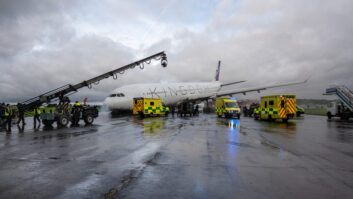 All aerial shots of the aircraft flying from Dubai to London are kosher. The production chartered a real Airbus and used three ‘camera ships’ to film it in the skies. The only bit of creative license was used for the livery – the name Kingdom and the colours that adorn the aircraft were the product of VFX – and occasionally in altering the terrain visible below.
All aerial shots of the aircraft flying from Dubai to London are kosher. The production chartered a real Airbus and used three ‘camera ships’ to film it in the skies. The only bit of creative license was used for the livery – the name Kingdom and the colours that adorn the aircraft were the product of VFX – and occasionally in altering the terrain visible below.
Other than that, it’s a truly authentic drama from one of the country’s most talented directors.

